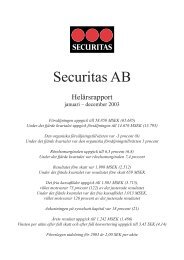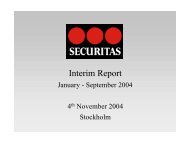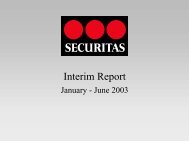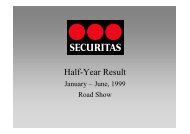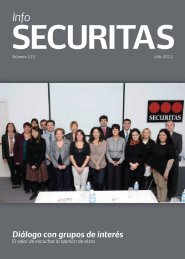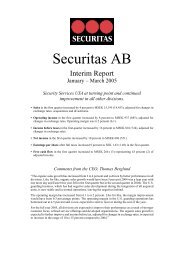Securitas AB Annual Report 2005
Securitas AB Annual Report 2005
Securitas AB Annual Report 2005
Create successful ePaper yourself
Turn your PDF publications into a flip-book with our unique Google optimized e-Paper software.
Recognition and subsequent measurement<br />
Purchases and sales of fi nancial instruments are recognised on trade-date – the<br />
date on which the Group commits to purchase or sell the instrument.<br />
Financial instruments are initially recognized at fair value plus transaction<br />
costs for all fi nancial assets or fi nancial liabilities not carried at fair value through<br />
profi t or loss.<br />
Financial assets are derecognized when the rights to receive cash fl ows from<br />
the instruments have expired or have been transferred and the Group has transferred<br />
substantially all risks and rewards of ownership. Financial liabilities are<br />
removed when the obligation is discharged, cancelled or expired.<br />
Financial assets or fi nancial liabilities at fair value through profi t or loss and<br />
available-for-sale fi nancial assets are subsequently carried at fair value. Loans and<br />
receivables and held-to-maturity investments are carried at amortized cost using<br />
the effective interest method. Realised and unrealised gains and losses arising<br />
from changes in the fair value of the fi nancial assets or liabilities at fair value<br />
through profi t or loss category are included in the income statement in the period<br />
in which they arise. Financial liabilities with the exception of fi nancial liabilities at<br />
fair value through profi t or loss and fi nancial liabilities designated for hedging are<br />
subsequently carried at amortized cost. Financial liabilities designated for hedging<br />
that qualify for fair value hedge accounting are subsequently carried at fair value.<br />
Changes in the fair value are included in the income statement in the period in<br />
which they arise. The corresponding gain or loss from re-measuring the hedging<br />
instrument at fair value is also included in the income statement in the same period<br />
as that in which the gain or loss on the hedged item arises. Cash fl ow hedging<br />
instruments are carried at fair value in the balance sheet and the gain or loss from<br />
re-measuring the hedging instrument at fair value are recognized in the hedging<br />
reserve in equity with a reversal from the hedging reserve to the statement of<br />
income in the period of which the cash fl ow of the hedged item impacts the statement<br />
of income. Exchange rate gains and losses on derivatives that are part of a<br />
net investment hedge relationship are recognized in equity.<br />
Actual cash fl ows that arise from derivative instruments are recognized as<br />
interest income and/or interest expense in the period to which they relate. Changes in<br />
fair value for both the hedged instrument and the hedging instrument (derivative) is<br />
recognized separately as Revaluation of fi nancial instruments. The line Revaluation<br />
of fi nancial instruments is included within Financial income and/or Financial<br />
expense. The separation of the result in interest and revaluation effects increases<br />
the ability to compare the effects with the effects under Swedish GAAP as well as<br />
separating unrealized changes in fair value from the actual cash fl ows that forms<br />
the basis for recognition of both interest income and interest expense.<br />
The fair values of quoted fi nancial instruments are based on current bid prices.<br />
If the market for a fi nancial instrument is not active (and for unlisted securities),<br />
the Group establishes fair value by using valuation techniques. These include the<br />
use of recent arm’s length transactions, reference to other instruments that are<br />
substantially the same, discounted cash fl ow analysis, and option pricing models<br />
refi ned to refl ect the issuer’s specifi c circumstances.<br />
Impairment of fi nancial assets<br />
The Group assesses at each balance sheet date whether there is objective evidence<br />
that a fi nancial asset or a group of fi nancial assets is impaired.<br />
Financial Instruments: Recognition and Measurement (IFRS 2004 and<br />
Swedish GAAP 2004) – to December 31, 2004<br />
Financial Instruments: Disclosure and Presentation<br />
IAS 32 (and according to Swedish GAAP, RR 27) Financial Instruments: Disclosure<br />
and Presentation stipulates the balance sheet classifi cation of fi nancial instruments<br />
and the disclosures to facilitate understanding of how fi nancial instruments<br />
infl uence income, fi nancial position and cash fl ow. The recommendation does not<br />
stipulate when fi nancial instruments should be recognized, or de-recognized from<br />
the balance sheet, nor does it indicate how such fi nancial instruments should be<br />
valued.<br />
Short-term investments<br />
Short-term investments are accounted according to the lower of cost or market<br />
principle if they pertain to transferable securities, and at acquisition value for bank<br />
deposits.<br />
Convertible debenture loans<br />
Convertible debenture loans are compound fi nancial instruments whose fi nancial<br />
liability (the loan) and the shareholders’ equity-related instrument (the issued put)<br />
should be accounted separately at the time of issue. Because the convertible debenture<br />
loan 2002/2007 series 1–4 was issued at market interest, the related shareholders’<br />
equity-related instrument constituted an insignifi cant portion of the issue<br />
proceeds, whereupon the convertible debenture loan was classifi ed as a fi nancial<br />
liability in its entirety.<br />
Notes and comments to the consolidated fi nancial statements<br />
Bond loans issued<br />
Bond loans issued are accounted at amortized cost, which means the present value<br />
of future payments calculated by the effective historical rate of interest at the time<br />
of issue.<br />
Commercial paper issued<br />
Commercial paper has been issued as part of a short-term Swedish commercial<br />
paper program and accounted under Other short-term loan liabilities at the original<br />
settlement value. Accrued interest is accounted under Accrued interest expenses<br />
using a linear valuation method. Due to the short tenor of issued commercial<br />
paper, the difference between accrued interest estimated linearly and by discounting<br />
is immaterial.<br />
Derivatives<br />
Loan receivables and loan liabilities hedged through forward currency contracts are<br />
valued at the spot rate on the day the hedge was entered into. Forward premiums<br />
and discounts, that is the difference between the forward rate and the spot rate,<br />
are accounted as interest.<br />
Interest rate derivatives are used for hedging purposes only and accounted<br />
through the deferral of unrealized gains and losses, known as deferral hedge<br />
accounting. As a result, the Group’s gains or losses from interest rate derivatives –<br />
comprises only interest income and interest expenses based on actual cash fl ows<br />
from interest rate derivatives. Option premiums paid are expensed over the term<br />
of the hedged position and are accounted as interest expenses.<br />
Employee Benefi ts (IAS 19)<br />
The Group operates or participates in a number of defi ned benefi t and defi ned contribution<br />
pension and other long-term employee benefi t plans. Other plans primarily<br />
relates to healthcare benefi ts. Calculations for the defi ned benefi t plans that exist<br />
within <strong>Securitas</strong> are carried out yearly by independent actuaries.<br />
Costs for defi ned benefi t plans are estimated using the so-called Projected Unit<br />
Credit method in a way that distributes the cost over the employee’s working life.<br />
Obligations are valued at the present value of the expected future cash fl ows using<br />
a discount interest rate corresponding to the interest rate on high quality corporate<br />
bonds or government bonds with remaining term that is approximately the same as<br />
the obligations. Plan assets are measured at fair value.<br />
Gains and losses resulting from changes in actuarial assumptions, plan experience<br />
and investment performance differing from that assumed are spread evenly in<br />
the income statement over the future working life of the employees in the plan to<br />
the extent that the accumulated gains and losses at the balance sheet date fall outside<br />
the so called corridor at the start of the period. This corridor corresponds to<br />
10 percent of the higher of the defi ned benefi t obligation and the value of plan<br />
assets at the balance sheet date.<br />
If accounting for a defi ned benefi t plan results in a balance sheet asset, this is<br />
reported as a net asset in the consolidated balance sheet under Other long-term<br />
receivables. Otherwise it is reported as a provision under Provisions for pensions<br />
and similar commitments. Costs related to defi ned benefi t plans, including the<br />
interest element, are accounted for in operating income. Provisions for pensions<br />
and similar commitments are not included in net debt.<br />
Payments under defi ned contribution plans are recognized in the period in<br />
which the employees have rendered their services. The expense is taken as the<br />
contributions payable during the period.<br />
Share-based payments (IFRS 2)<br />
IFRS 2 requires that the fair value of the equity settled schemes should be accounted<br />
for as an expense in the statement of income with the corresponding entry accounted<br />
for as equity. The expense should be accrued for on a linear basis over the vesting<br />
period. For cash settled schemes IFRS 2 also requires that the fair value of the<br />
scheme should be accounted for as an expense in the statement of income on a<br />
linear basis over the vesting period, but with the corresponding entry recognized<br />
as a liability rather than as equity. Furthermore if the incentive scheme lapses<br />
without settlement this will result in a reversal of the accrued cost for cash settled<br />
schemes only. For equity settled schemes no reversal will occur since no adjustment<br />
to the net assets is required.<br />
<strong>Securitas</strong> have no equity settled or cash settled schemes that would fall within<br />
the scope of this standard.<br />
Provisions (IAS 37)<br />
Provisions are recognized when the Group has a present obligation as a result of<br />
a past event and it is probable that an outfl ow of resources embodying economic<br />
benefi ts will be required to settle the obligation and a reliable estimate can be<br />
made of the amount of the obligation.<br />
Claims reserves are calculated on the basis of a combination of case reserves,<br />
which represent claims reported, and IBNR (incurred but not reported) reserves.<br />
Actuarial calculations are performed quarterly to assess the adequacy of the<br />
reserves based on open claims and historical IBNR. The provisions are recognized<br />
in the balance sheet at the discounted value that has been established by the actuarial<br />
calculations.<br />
SECURITAS <strong>2005</strong> 83




